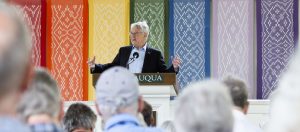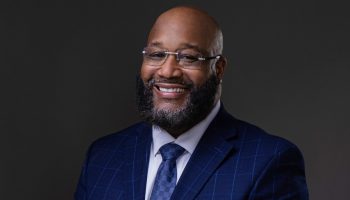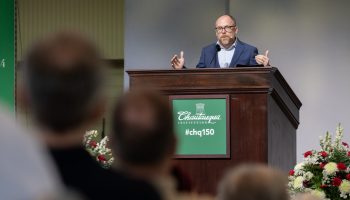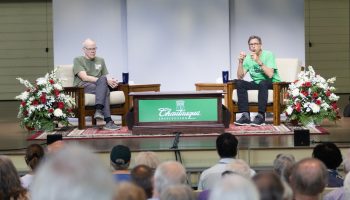
On Monday in the Hall of Philosophy, James Fallows, a national correspondent for The Atlantic and co-founder of the publication’s American Futures project, shared his experiences from traveling around the country in the past year and witnessing the accomplishments of small communities overlooked by national media.
Before beginning his lecture, Fallows previewed the interfaith lectures for the week. Judy Shepard, whose son was murdered out of anti-gay hate in 1998, spoke with Fallows Tuesday in the Hall of Philosophy. The remaining interfaith lectures this week include a presentation with high school teacher Chuck Yarborough, and two students from the Mississippi School of Mathematics and Sciences in Columbus, Mississippi, on Wednesday; and with Emily and Stuart Siegel on Thursday.
“The (MSMS) is a phenomenal place,” Fallows said. “It is a public, residential high school in Mississippi for students who are from all around the state and gather there. While their stated specialty is math and science … (they use) the arts and humanities to deal with what is Mississippi’s legacy and America’s legacy — slavery and its aftermath.”
Fallows will join the Siegels and their son, who work in Ajo, Arizona, a town being revitalized “in an act of will, creativity, artistic imagination and generosity” by the Siegels and other residents there.
In his lecture, “Is Common Good a Lost Cause? Sources of Strain, and Re-Connection, in Modern America,” which began Week Two of Chautauqua’s Interfaith Lecture Series, “Common Good Change Agents,” Fallows discussed some of the positive changes communities have made and how this type of action needs to percolate up to more influential levels.
“The two main messages we were trying to convey when we spoke here last year was, number one, the sharp contrast between how the United States of this moment looks at the national level, where most people — regardless of their political affiliation — are concerned, unhappy or downcast about the state of the nation as a whole, and the way it looks city by city,” Fallows said.
After speaking at Chautauqua last year, Fallows and his wife, Deborah, spent the next 11 months on the road visiting small towns and cities, partly because they are making a film with HBO, based on their book, Our Towns: A 100,000-Mile Journey Into the Heart of America. The Fallows also traveled across the country to learn and to find patterns that “augment what we’ve seen before,” Fallows said.
Fallows then went through a list of 10 cities that he and his wife not only visited, but learned from and were positively impacted by.
The first city was Charlotte, North Carolina, where citizens prided themselves on the city’s thriving industry. One academic study, Fallows said, compared Charlotte to some 100 cities across the United States for “trust across racial lines … and other indications of wholesome civic fabric.”
“Of all the cities on the list, Charlotte came in last, which was shocking to people there,” Fallows said. “The reaction locally was not denialism, defensiveness, challenging the report … but rather saying, ‘This is something we need to take seriously.’ ”
Now, there are a group of foundations, lecture series and libraries that engage more citizens and allow Charlotte to be more inclusive, he said.
The next place was Danville, Virginia, which is known for being the last capital of the Confederacy, and was also known as a mill town. If one didn’t work in the mills, the only other option was to work in tobacco warehouses. With that said, Danville suffered a major economic blow when the mills and tobacco industry left town.
So, Danville sat with no industrialization, a ruined economic foundation and a history of racism and slavery. Despite what sounds like dark times, citizens of Danville have found opportunities to worktogether and across racial lines toward a better future for the town, Fallows said.
“They received a settlement from the tobacco case. … Danville used its money to build the equivalent of a research university, a sort of high-tech center to create new economic opportunities,” Fallows said. “What has been impressive in Danville has been the effort across the lines of the traditional racial divide to make a new future. The downtown historical buildings have been reconverted to lofts, restaurants and markets that draw people back in.”
Third, Fallows discussed Muncie, Indiana, the home of the Ball brothers’ glass canning empire, Ball Corporation, and home to a troubled public school system. As of three years ago, Indiana had to put two public school systems in state receivership — one in Gary, and the other in Muncie, where draining of students from school systems had become a challenge.
Muncie’s step toward “public good” was through Ball State University. For the first time in known American history, this major public university took over responsibility for the City of Muncie public schools.
“The president of Ball State has made this part of his mission to be community involved and to recognize that to create this new school system, it needed to be inclusive and common good-guided in every way it could be,” Fallows said. “For a town with long-standing racial divides, they did everything they could to include people of different racial categories and income categories.”
The fourth location was Fort Wayne, Indiana. Fort Wayne had relied on a General Electric plant, before the company abandoned the town. Groups of young people, older people, public institutions and private institutions decided to turn “the shame of the community into the center of the community,” Fallows said.
“They are using (the plant) as a new hospital space and startup space and living space,” he said. “If you go to Fort Wayne, I encourage you to see this old building, a kind of Stonehenge of one industrial era of America, fostering space for another.”
Next on Fallows’ list was Pensacola, Florida, a town trying to make itself “the laboratory for democracy in the United States.”
There, a man by the name of Quint Studer believes it is his lifelong mission to develop techniques of civic engagement, collaborative reasoning and the common good for his town and then allow the techniques to spread throughout the country.
“If you go to Pensacola, you will see a series they have called CivicCon where they try to enlist people who are working with a newspaper or working with everybody else to express that this is a connected community,” Fallows said.
The Latino-populated and largely impoverished Brownsville, Texas, became the focus of a June tragedy, after a Salvadoran father and daughter both drowned while attempting to cross into Texas via the Rio Grande River. Despite Brownsville’s poverty rate, Fallows said there are minimal drug problems. Fallows attributes this partly to familial ties.
“The family structure of the overwhelmingly Latino families is strong enough that young people have, in particular, a mother and a grandmother who are watching what they’re doing,” Fallows said. “So, Brownsville has a kind of civic fiber despite economic poverty.”
The residents of Brownsville are also working to bring more people to the town. The downtown area is old but has the potential to be made into “a new downtown.”
The seventh city is San Bernardino, California. It’s the most troubled city in California, and one of the most troubled in the United States. But now, Fallows said, the city has arguably “the most impressive public high schools in the state.”
Fallows said a business person, who felt a religious calling to be involved in the schools, worked to develop opportunities for students of all backgrounds to prepare for skilled, technical jobs and higher education.
Fallows then discussed Kenosha and Racine, Wisconsin, which have well-known racial and deindustrialization problems. There, a local college has taken on the responsibility of the city and the community. Additionally, a company called Snap-On, decided that “(its) well-being depends on the well-being of the community.”
Houston, one of the largest U.S. cities, was the ninth location; that city has developed a program called Report for America, whose purpose is to send young reporters to small newspapers throughout the country to do local reporting.
“If you’re looking for somewhere to put your money, I would look at Report for America,” Fallows said. “Their entire goal is to advance the common good.”
Lastly, Fallows talked about the largest city in the United States: New York City. Specifically, in the New York City public libraries, Deborah Fallows reported on an innovation that made books available to the blind.
“These are things Deb and I didn’t know when we saw you all a year ago,” Fallows said, “of how widespread is this sense of innovation to try to address the problems of us in the broadest sense.”
With those cities and towns in mind, Fallows presented an action plan for improving the state of American cities. First, one must keep their eyes open and “simply notice” how much is happening in the country. Then, it is crucial to “see the patterns.”
“The third stage is where we ask, ‘what can people involved in the flotilla of renewed efforts do to magnify their efforts (and) give more leverage to what they’re all doing?’ ” Fallows said.
Fallows said a significant number of faith organizations are involved in efforts like refugee and immigrant resettlement. Many organizations also work with the homeless and try to address drug problems, among other things. There are rural revival centers scattered throughout the country and community foundations and universities. Even libraries are considered to be the new “civic convenors.”
“Deb and I are now thinking of what we can do to better connect, and tell the stories of and increase the power of the local-level groups who have locally based solutions for improvement,” Fallows said. “Then, the good that is happening at the local level can percolate up and offset the bad that is, in many places, seeping down from the national level.”
Fallows posed a series of questions about the actual power of the local level and its influence on the national level.
“What if the power of example, locally, doesn’t work?” Fallows asked. “What if the strains on the national government finally are at a point where they don’t really recover from them? What do we think is the best way forward if that is the case?”
These are the “eternal questions of American life,” Fallows said. The question is one of balance between the central and the local, the federal and the state, Thomas Jefferson and Alexander Hamilton.
“We have been here before,” Fallows said. “Deb and I think that all of us here are part of answering that question of whether we can establish a common good. … It’s something that depends on people’s actions locally; it depends on their imagination springing beyond the community and the local, and it depends on the ever-expanding sense of what the common good is, and that is what we hope to explore through the conversations this next week.”




